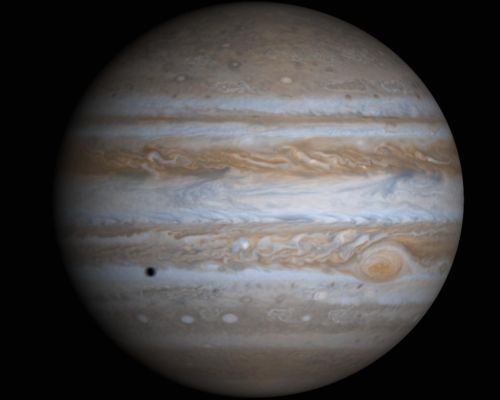
As darkness falls tomorrow (Dec. 6), check out the east-southeast sky. You'll see a bright waxing gibbous moon, nearly 90 percent illuminated, and shining brilliantly to the lower right of the moon will be a brilliant silvery "star" gleaming with a steady glow.
That's not a star, though, but the "king of the planets," Jupiter.
The moon and Jupiter will be closest together during the afternoon, and they will be slowly separating during the overnight hours of tomorrow and Wednesday morning. During the evening they'll be separated by about 5 or 6 degrees (for comparison, your clenched fist held at arm's length measures about 10 degrees and the moon moves across the sky at about its own diameter each hour).
Jupiter remains a bold light high in the east-southeast at nightfall. This week it doesn't set in the west until around 3:30 a.m. local time.
Although brighter than any nighttime star, Jupiter blazes less fiercely now than in previous months. One glance toward the southwest before 6:30 p.m. local time will readily show that Venus outshines it. Jupiter appears to be levitating in front of the sparse stars of eastern Pisces, filling this region of the sky with overbearing brightness.
What kind of telescopic observation can be made now? Almost any kind. From mid-northern latitudes you could even watch a full rotation of Jupiter, with the cloud features of every longitude displayed, during a single nightlong vigil. And as always, a fascinating dance of Jupiter's four large satellites will await viewers on any night who watch with a small telescope or even steadily held binoculars. [Video: Top 10 Amateur Telescopes]
As darkness falls over the eastern United States tomorrow, you'll see two of Jupiter's moons — Ganymede and Europa — on one side of the planet, while a third, Callisto, hovers by itself on the other side.
Get the Space.com Newsletter
Breaking space news, the latest updates on rocket launches, skywatching events and more!
As the evening progresses, notice how Ganymede and Europa will gradually pull away from Jupiter, but then at 8:21 p.m. EST (5:21 p.m. PST), a fourth satellite (Io) will emerge from Jupiter's shadow and l appear on the side of Jupiter occupied by Callisto. Slowly, as tomorrow night wears on, Io will become easier to see as it moves away from Jupiter and toward Callisto.
Keep in mind that during this time, Jupiter's distance from Earth is increasing, from 34.8 light-minutes now to 37.7 light-minutes by the end of December (a light-minute is the distance light can travel in a minute — about 11 million miles, or 18 million kilometers). The apparent size of Jupiter's disk is therefore shrinking too; in fact, it will be nearly 13 percent smaller by year's end compared to when it was at opposition to the sun in late October.
Nonetheless, Jupiter will continue to be a great target for those who might acquire binoculars or a telescope for the holidays over this upcoming winter season.
Joe Rao serves as an instructor and guest lecturer at New York's Hayden Planetarium. He writes about astronomy for The New York Times and other publications, and he is also an on-camera meteorologist for News 12 Westchester, New York.
Join our Space Forums to keep talking space on the latest missions, night sky and more! And if you have a news tip, correction or comment, let us know at: community@space.com.

Joe Rao is Space.com's skywatching columnist, as well as a veteran meteorologist and eclipse chaser who also serves as an instructor and guest lecturer at New York's Hayden Planetarium. He writes about astronomy for Natural History magazine, Sky & Telescope and other publications. Joe is an 8-time Emmy-nominated meteorologist who served the Putnam Valley region of New York for over 21 years. You can find him on Twitter and YouTube tracking lunar and solar eclipses, meteor showers and more. To find out Joe's latest project, visit him on Twitter.










